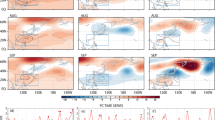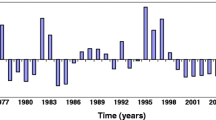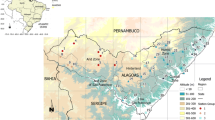Abstract
This paper investigates the impact of the Madden-Julian Oscillation (MJO) on the diurnal cycle of rainfall over the western Maritime Continent during the austral summer. For this purpose, cyclostationary empirical orthogonal function analysis is applied to the tropical rainfall measuring mission rain rate and the Japanese Reanalysis-25 data for the period 1998–2008. The real-time multivariate MJO index by Wheeler and Hendon (Mon Wea Rev 132:1917–1932, 2004) is adopted to define the intensity and the phase of MJO. It is demonstrated that the hourly maximum rain rate over the domain tends to increase when convectively active phase of MJO approaches the Maritime Continent. In contrast, the hourly maximum rain rate tends to decrease when convectively suppressed phase of MJO resides over the region. The changes in the rain rate due to MJO differ over the ocean and the land. This difference is the greatest when the MJO is in the mature stage. Throughout the day during this stage, terrestrial rain rates show minimum values while diurnally varying oceanic rain rates record maximum values. Thus, precipitation becomes more intense in the morning over the Java Sea and is weakened in the evening over Borneo and Sumatra during the mature stage of MJO. During the decaying stage of MJO over the Maritime Continent, the diurnal cycle of precipitation weakens significantly over the ocean but only weakly over land. Analyses suggest that the anomalous lower level winds accompanied by MJO interact with the monsoonal flow over the Maritime Continent. Westerlies induced by MJO convection in the mature stage are superimposed on the monsoonal westerlies over the equator and increase wind speed mainly over the Java Sea due to the blocking effect of orography. Mountainous islands induce flow bifurcation, causing near-surface winds to converge mainly over the oceanic channels between two islands. As a result, heat flux release from the ocean to the atmosphere is enhanced by the increased surface wind resulting in instability as described in the wind-induced surface heat exchange mechanism. This may contribute to heavy rainfall over the Java Sea in the morning during the mature stage. On the other hand, convergence and vertical velocity over the islands, which play important roles in inducing nighttime rainfall, tend to be weak in the evening during the mature stage of MJO. Strong westerlies arising from MJO and the seasonal flow during the mature stage tend to interrupt convergence over islands. This interruption of convergence by MJO gives rise to decreased rain rates over the land regions.












Similar content being viewed by others
References
Bowman K, Collier J, North G, Wu Q, Ha E, Hardin J (2005) Diurnal cycle of tropical precipitation in tropical rainfall measuring mission (TRMM) satellite and ocean buoy rain gauge data. J Geophys Res. doi:10.1029/2005JD005763
Byon J, Lim G (2005) Diurnal variation of tropical convection during TOGA COARE IOP. Adv Atmos Sci 22:685–702
Chen S, Houze Jr R (1997) Diurnal variation and life-cycle of deep convective systems over the tropical Pacific warm pool. Q J R Meteorol Soc 123(538):357–388
Dayem K, Noone D, Molnar P (2007) Tropical western Pacific warm pool and maritime continent precipitation rates and their contrasting relationships with the Walker Circulation. J Geophys Res 112. doi:10.1029/2006JD007870
Emanuel K (1987) An air-sea interaction model of intraseasonal oscillations in the tropics. J Atmos Sci 44:2324–2340
Hall J, Matthews A, Karoly D (2001) The modulation of tropical cyclone activity in the Australian region by the Madden-Julian oscillation. Mon Weather Rev 129:2970–2982
Hamada J, Yamanaka M, Matsumoto J, Fukao S, Winarso P, Sribimawati T (2002) Spatial and temporal variations of the rainy season over Indonesia and their link to ENSO. J Meteorol Soc Jpn 80:285–310
Hendon H, Liebmann B (1990) The Intraseasonal (30–50 day) Oscillation of the Australian summer monsoon. J Atmos Sci 47:2909–2924
Hendon H, Salby M (1994) The life cycle of the Madden-Julian oscillation. J Atmos Sci 51:2225–2237
Houze R Jr, Geotis S, Marks F Jr, West A (1981) Winter monsoon convection in the vicinity of North Borneo. Part I: structure and time variation of the clouds and precipitation. Mon Weather Rev 109:1595–1614
Hsu H, Lee M (2005) Topographic effects on the eastward propagation and initiation of the Madden-Julian oscillation. J Clim 18:795–809
Huffman G, Adler R, Bolvin D, Gu G, Nelkin E, Bowman K, Hong Y, Stocker E, Wolff D (2007) The TRMM multisatellite precipitation analysis (TMPA): Quasi-global, multiyear, combined-sensor precipitation estimates at fine scales. J Hydro 8:38–55
Ichikawa H, Yasunari T (2006) Time-space characteristics of diurnal rainfall over Borneo and surrounding oceans as observed by TRMM-PR. J Clim 19:1238–1260
Ichikawa H, Yasunari T (2007) Propagating diurnal disturbances embedded in the Madden-Julian Oscillation. Geophys Res Lett 34. doi:10.1029/2007GL030480
Ichikawa H, Yasunari T (2008) Intraseasonal variability in diurnal rainfall over New Guinea and the surrounding oceans during austral summer. J Clim 21:2852–2868
Johnson R, Kriete D (1982) Thermodynamic and circulation characteristics, of winter monsoon tropical mesoscale convection. Mon Weather Rev 110:1898–1911
Kessler W, Kleeman R (2000) Rectification of the Madden-Julian oscillation into the ENSO cycle. J Clim 13:3560–3575
Kim K, North G (1997) EOFs of harmonizable cyclostationary processes. J Atmos Sci 54:2416–2427
Kim K, North G, Huang J (1996) EOFs of one-dimensional cyclostationary time series: computations, examples, and stochastic modeling. J Atmos Sci 53:1007–1017
Lawrence D, Webster P (2002) The boreal summer intraseasonal oscillation: relationship between northward and eastward movement of convection. J Atmos Sci 59:1593–1606
Liberti G, Cheruy F, Desbois M (2001) Land effect on the diurnal cycle of clouds over the TOGA COARE area, as observed from GMS IR data. Mon Weather Rev 129:1500–1517
Lim G, Seo A (2000) Diurnal and semidiurnal variations in the time series of 3-hourly assimilated precipitation by NASA GEOS-1. J Clim 16:2923–2940
Maloney E, Hartmann D (2000) Modulation of eastern North Pacific hurricanes by the Madden-Julian oscillation. J Clim 13:1451–1460
Matsumoto J (1992) The seasonal changes in Asian and Australian monsoon regions. J Meteor Soc Jpn 70:257–273
Mori S, Jun-Ichi H, Tauhid Y, Yamanaka M, Okamoto N, Murata F, Sakurai N, Hashiguchi H, Sribimawati T (2004) Diurnal land-sea rainfall peak migration over Sumatera Island, Indonesian Maritime Continent, observed by TRMM satellite and intensive rawinsonde soundings. Mon Weather Rev 132:2021–2039
Neelin J, Held I, Cook K (1987) Evaporation-wind feedback and low-frequency variability in the tropical atmosphere. J Atmos Sci 44:2341–2348
Nesbitt S, Zipser E (2003) The diurnal cycle of rainfall and convective intensity according to three years of TRMM measurements. J Clim 16:1456–1475
Onogi K, Tsutsui J, Koide H, Sakamoto M, Kobayashi S, Hatsushika H, Matsumoto T, Yamazaki N, Kamahori H, Takahashi K, Kadokura S, Wada K, Kato K, Oyama R, Ose T, Mannoji N, Taira R (2007) The JRA-25 reanalysis. J Meteor Soc Jpn 85:369–432
Qian J (2008) Why precipitation is mostly concentrated over islands in the maritime continent. J Atmos Sci 65:1428–1441
Ramage C (1971) Monsoon meteorology. Academic Press, New York, p 295
Rui H, Wang B (1990) Development characteristics and dynamic structure of tropical intraseasonal convection anomalies. J Atmos Sci 47:357–379
Seo K, Kim K (2003) Propagation and initiation mechanisms of the Madden-Julian oscillation. J Geophys Res 108:4384. doi:10.1029/2002JD002876
Slingo J, Sperber K, Boyle J, Ceron J, Dix M, Dugas B, Ebisuzaki W, Fyfe J, Gregory D, Gueremy J (1996) Intraseasonal oscillations in 15 atmospheric general circulation models: results from an AMIP diagnostic subproject. Clim Dyn 12:325–357
Sperber K (2003) Propagation and the vertical structure of the Madden-Julian oscillation. Mon Weather Rev 131:3018–3037
Sui C, Lau K (1992) Multiscale phenomena in the tropical atmosphere over the western Pacific. Mon Weather Rev 120:407–430
Tian B, Waliser D, Fetzer E (2006) Modulation of the diurnal cycle of tropical deep convective clouds by the MJO. Geophys Res Lett 33. doi:10.1029/2006GL027752
Wheeler M, Hendon H (2004) An all-season real-time multivariate MJO index: development of an index for monitoring and prediction. Mon Weather Rev 132:1917–1932
Wu C, Hsu H (2009) Topographic influence on the MJO in the maritime continent. J Clim 22:5433–5448
Yang G, Slingo J (2001) The diurnal cycle in the tropics. Mon Weather Rev 129:784–801
Yang S, Smith E (2006) Mechanisms for diurnal variability of global tropical rainfall observed from TRMM. J Clim 19:5190–5226
Zhang C (2005) Madden-Julian oscillation. Rev Geophys 43:RG2003. doi:10.1029/2004RG000158
Zhang C, Gottschalck J (2002) SST anomalies of ENSO and the Madden-Julian oscillation in the Equatorial Pacific. J Clim 15:2429–2445
Zhou L, Wang Y (2006) Tropical rainfall measuring mission observation and regional model study of precipitation diurnal cycle in the New Guinean region. J Geophys Res 111. doi:10.1029/2006JD007243
Acknowledgments
This work was funded by the Korea Meteorological Administration Research and Development Program under Grant CATER 2006‐2201. J.‐H. Oh and G.‐H. Lim were supported by the second stage of the Brain Korea 21 Project.
Author information
Authors and Affiliations
Corresponding author
Rights and permissions
About this article
Cite this article
Oh, JH., Kim, KY. & Lim, GH. Impact of MJO on the diurnal cycle of rainfall over the western Maritime Continent in the austral summer. Clim Dyn 38, 1167–1180 (2012). https://doi.org/10.1007/s00382-011-1237-4
Received:
Accepted:
Published:
Issue Date:
DOI: https://doi.org/10.1007/s00382-011-1237-4




